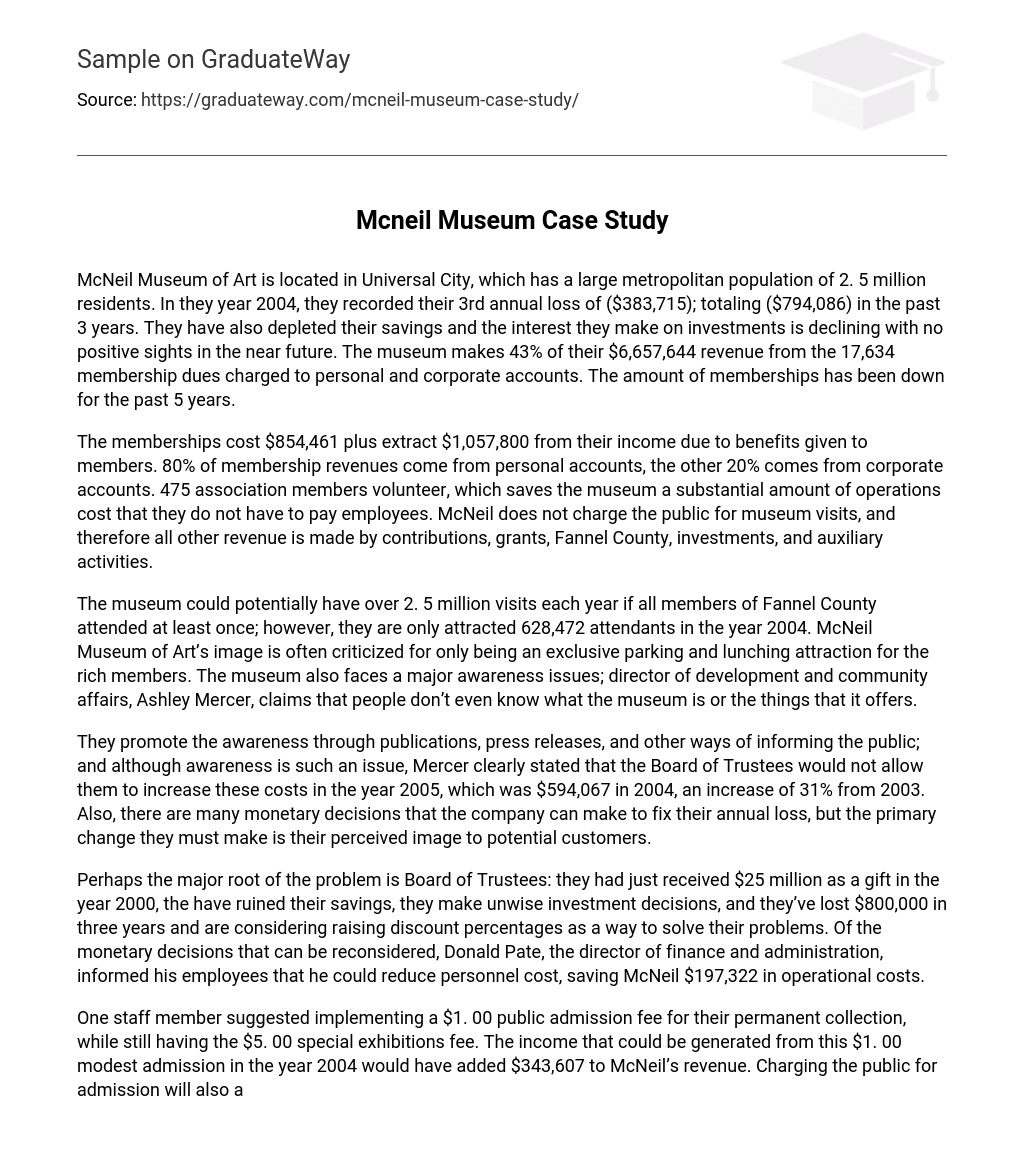McNeil Museum of Art is located in Universal City, which has a large metropolitan population of 2. 5 million residents. In they year 2004, they recorded their 3rd annual loss of ($383,715); totaling ($794,086) in the past 3 years. They have also depleted their savings and the interest they make on investments is declining with no positive sights in the near future. The museum makes 43% of their $6,657,644 revenue from the 17,634 membership dues charged to personal and corporate accounts. The amount of memberships has been down for the past 5 years.
The memberships cost $854,461 plus extract $1,057,800 from their income due to benefits given to members. 80% of membership revenues come from personal accounts, the other 20% comes from corporate accounts. 475 association members volunteer, which saves the museum a substantial amount of operations cost that they do not have to pay employees. McNeil does not charge the public for museum visits, and therefore all other revenue is made by contributions, grants, Fannel County, investments, and auxiliary activities.
The museum could potentially have over 2. 5 million visits each year if all members of Fannel County attended at least once; however, they are only attracted 628,472 attendants in the year 2004. McNeil Museum of Art’s image is often criticized for only being an exclusive parking and lunching attraction for the rich members. The museum also faces a major awareness issues; director of development and community affairs, Ashley Mercer, claims that people don’t even know what the museum is or the things that it offers.
They promote the awareness through publications, press releases, and other ways of informing the public; and although awareness is such an issue, Mercer clearly stated that the Board of Trustees would not allow them to increase these costs in the year 2005, which was $594,067 in 2004, an increase of 31% from 2003. Also, there are many monetary decisions that the company can make to fix their annual loss, but the primary change they must make is their perceived image to potential customers.
Perhaps the major root of the problem is Board of Trustees: they had just received $25 million as a gift in the year 2000, the have ruined their savings, they make unwise investment decisions, and they’ve lost $800,000 in three years and are considering raising discount percentages as a way to solve their problems. Of the monetary decisions that can be reconsidered, Donald Pate, the director of finance and administration, informed his employees that he could reduce personnel cost, saving McNeil $197,322 in operational costs.
One staff member suggested implementing a $1. 00 public admission fee for their permanent collection, while still having the $5. 00 special exhibitions fee. The income that could be generated from this $1. 00 modest admission in the year 2004 would have added $343,607 to McNeil’s revenue. Charging the public for admission will also add value to obtaining a membership, because members will still be allowed to come and go for free; this could, in no way, hurt membership numbers.
The museum gift shop, skyline buffet, and museum association are all not breaking even; these should be their most profitable areas, which again points back to the board of trustees and those running the museum to be the root of the problem. The gift shop contributed ($82,519) to the 2004 loss, the buffet ($76,208), and the associations ($7,819). 65% of these gift shop and skyline buffet earnings come from 15% discount purchases, meaning that 65% of their sales are likely from members.
The discount should certainly not increase, which was a suggestion for increasing 2005 revenue; but whether or not it should still be implemented is the real consideration. For a $100 purchase, if they continue the status quo, only $85 will contribute to revenue. Another option, not even considered by those in charge, would to continue the perceived value of a 15% revenue and actually increase the price 15%. Therefore, that $100 gift now costs $115, and with a 15% discount the museum will still make $97.
75- a lot closer to $100 and doesn’t upset the members. Another suggestion was to close the buffet, but this is an unwise consideration because it is appreciated highly by corporate memberships, and these accounts cost anywhere between $2,500 and $10,000 to join and have a 75% renewal rate. Their least expensive membership is the most popular, accounting for 78% of all memberships; therefore, the $30 membership for senior citizens and students suggestion would likely sell and have a positive effect on their perceived image as an elite group.
These two segments had not been reached before, and education the public is important to this museum’s mission. More members will mean more discounts, which will increase revenue in auxiliary activities as well. Plus, this will increase the amount of volunteers, which could further reduce operational costs. Finally, this means more people bringing friends and family to the museum with them. The direct mailing is an inefficient operational cost of $66,488. 80; it only has a 1% response rate.
Additionally, it is most commonly used for $50 memberships, which only have a 30% renewal rate the first year and 50% the following years. The $50 revenue contributed by one member actually cost ($46) from individual benefits [$631,016 / 13,672 members] plus ($43) from the individual marketing costs. One suggestion was to get rid of the $50 membership because of the negative contribution margin, however perhaps they should simply drop the mailing and contribute $66,488 to immediately fix their problems.
Essentially, there are many considerations that will turn around or at the very least stop McNeil Museum’s dramatic loss, but the most important thing they must first evaluate is the way that they’re handling themselves as a business in the first place. They are not being run strategically, and suggestions for their short-term problems will not stop the long-term issues they will certainly face.





